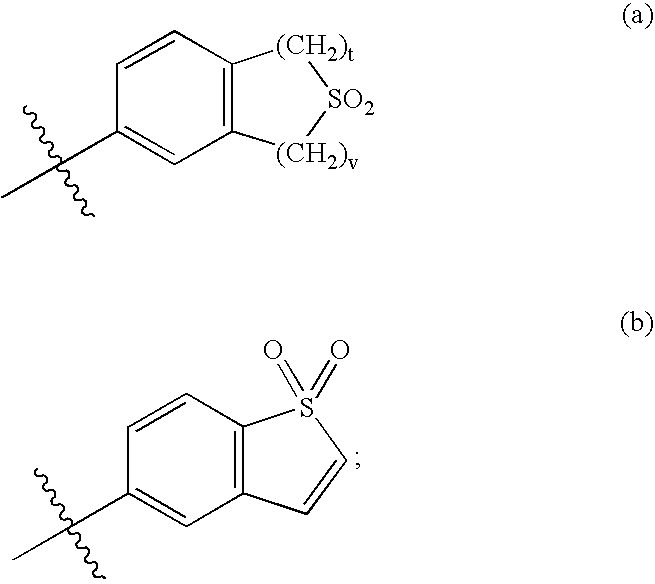Selective estrogen receptor modulators containing a phenylsulfonyl group
a technology of phenylsulfonyl group and estrogen receptor, which is applied in the direction of heterocyclic compound active ingredients, biocide, drug compositions, etc., can solve the problems of hampered clinical use of serm compounds for the treatment of uterine fibroid disease and/or endometriosis, especially in pre-, menopausal women
- Summary
- Abstract
- Description
- Claims
- Application Information
AI Technical Summary
Problems solved by technology
Method used
Image
Examples
preparation 1
Trifluoro-methanesulfonic acid 6-methoxy-1-[4-(2-piperidin-1-yl-ethoxy)-phenoxy]-naphthalen-2-yl ester
[0086] Add 6-methoxynaphthalene-2-ol (20 g, 114.8 mmol) to dimethylformamide (DMF, 250 mL) at ambient temperature followed by N-bromosuccinimide (BS, 21.5 g, 120 mmol) over a 30 minute period. After 45 minutes, dilute with water (800 mL), collect and dry the precipitate to provide 25.5 g (87%) of 1-bromo-6-methoxy-naphthalen-2-ol.
[0087] Add 1-bromo-6-methoxy-naphthalen-2-ol (66.7 g, 264 mmol), potassium carbonate (K2CO3, 40.0 g, 290 mmol) and benzyl bromide (49.6 g, 290 mmol) to DMF (800 mL). Stir the mixture at ambient temperature for 1 hour. Add water (400 mL) to precipitate the product. Collect the precipitate and wash the filter cake with heptane (3×125 mL) then dry to provide 83.7 g of 2-benzyloxy-1-bromo-6-methoxy-naphthalene (86.2%).
[0088] Combine toluene (200 mL), 2-benzyloxy-1-bromo-6-methoxy-naphthalene (30 g, 87.4 mmol), 4-(2-piperidin-1-yl-ethoxy)phenol (23.2 g, 105 m...
preparation 2
Trifluoro-methanesulfonic acid 6-hydroxy-1-[4-(2-piperidin-1-yl-ethoxy)-phenoxy]-naphthalen-2-yl-ester
[0091] Add 2M hydrogen chloride in ether (1.5 mL, 3 mmol) to a solution of the compound of Preparation 1 (1.07 g, 2.04 mmol) in dichloromethane (20 mL) and remove solvent under vacuum. Dissolve the hydrochloride salt in dichloromethane (40 mL) and cool in ice bath. Add boron tribromide (0.58 mL, 6.12 mmol), stir for 3.5 hours, warm to ambient temperature and stir for 15 minutes, cool in ice bath and quench with ice cold saturated aqueous sodium bicarbonate. Extract aqueous layer with dichloromethane, combine organic layers and dry with magnesium sulfate, remove solvent under vacuum and chromatograph on silica gel using dichloromethane / methanol mixtures to give 990 mg of the title compound (95%).
preparation 3
Trifluoro-methanesulfonic acid 6-benzyloxy-1-[4-(2-piperidin-1-yl-ethoxy)-phenoxy]-naphthalen-2-yl ester
[0092] Combine trifluoromethanesulfonic acid 6-hydroxy-1-[4-(2-piperidin-1-yl-ethoxy)-phenoxy]-naphthalen-2-yl ester (247 mg, 0.48 mmol), triphenylphosphine (190 mg, 0.725 mmol), benzyl alcohol (0.075 mL, 0.725 mmol) and tetrahydrofuran (5 mL) in a flask placed in an ice bath. Add diisopropyl azodicarboxylate (0.14 mL, 0.725 mmol), stir for 1 hour, warm to ambient temperature and stir for 30 minutes. Dilute with ethyl acetate and wash with 50% saturated aqueous sodium bicarbonate, saturated aqueous sodium chloride, dry with magnesium sulfate and remove solvent under vacuum. Chromatograph on silica gel with dichloromethane / methanol mixtures to give 213 mg of the title compound (73%).
PUM
| Property | Measurement | Unit |
|---|---|---|
| Acidity | aaaaa | aaaaa |
Abstract
Description
Claims
Application Information
 Login to View More
Login to View More - R&D
- Intellectual Property
- Life Sciences
- Materials
- Tech Scout
- Unparalleled Data Quality
- Higher Quality Content
- 60% Fewer Hallucinations
Browse by: Latest US Patents, China's latest patents, Technical Efficacy Thesaurus, Application Domain, Technology Topic, Popular Technical Reports.
© 2025 PatSnap. All rights reserved.Legal|Privacy policy|Modern Slavery Act Transparency Statement|Sitemap|About US| Contact US: help@patsnap.com



